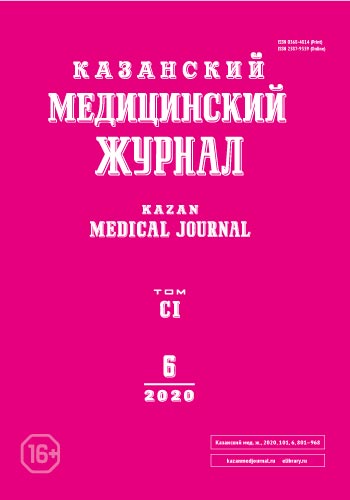Возможности дистанционного обучения в период эпидемии СOVID-19
- Авторы: Зиганшин А.М.1, Мудров В.А.2, Насырова С.Ф.1, Галимзянов В.З.1, Салимоненко Д.А.3, Алексеева А.Ю.2, Насибулин И.М.1, Ящук А.Г.1
-
Учреждения:
- Башкирский государственный медицинский университет
- Читинская государственная медицинская академия
- Башкирский государственный университет
- Выпуск: Том 101, № 6 (2020)
- Страницы: 876-882
- Раздел: Социальная гигиена и организация здравоохранения
- Статья получена: 10.09.2020
- Статья одобрена: 21.10.2020
- Статья опубликована: 14.12.2020
- URL: https://kazanmedjournal.ru/kazanmedj/article/view/43929
- DOI: https://doi.org/10.17816/KMJ2020-876
- ID: 43929
Цитировать
Аннотация
Цель. Сравнить результаты применения традиционных и дистанционных образовательных технологий в рамках обучения врачей акушеров-гинекологов на циклах непрерывного медицинского образования.
Методы. На базе кафедры акушерства и гинекологии с курсом дополнительного профессионального образования Башкирского государственного медицинского университета проведена оценка результативности применения традиционных и дистанционных образовательных технологий в рамках обучения врачей акушеров-гинекологов на циклах непрерывного медицинского образования. Исследование включало оценку знаний врачей акушеров-гинекологов, прошедших обучение по программе 36 часов. Было выделено две исследуемые группы. Первая группа включала 28 врачей, обучение и оценку знаний которых осуществляли преимущественно с использованием традиционных образовательных технологий. Во вторую группу вошли 30 врачей, обучение и оценку знаний которых проводили с использованием дистанционных образовательных технологий. Итоговую результативность применения исследуемых технологий оценивали на основании анализа результатов итогового тестирования и решения ситуационных клинических задач в форме общего собеседования. Результаты исследования были обработаны с помощью пакета статистических программ IBM SPSS Statistics Version 25.0.
Результаты. В ходе исследования выявлено, что применение дистанционных образовательных технологий не приводит к снижению степени обученности врачей: в первой группе она составила 70,0%, во второй группе — 60,7% (χ2=0,11, df=1, p=0,74). Между тем, дистанционный формат обучения вызывает затруднения у врачей старшей возрастной группы: в первой группе между возрастом и результативностью обучающегося существует прямая умеренная корреляционная связь (r=0,497, p=0,007), во второй группе — заметная обратная корреляционная связь (r=–0,689, p <0,001).
Вывод. С учётом полученных результатов исследования в дальнейшем следует дифференцированно подходить к формированию групп для дистанционного обучения.
Ключевые слова
Полный текст
Об авторах
Айдар Миндиярович Зиганшин
Башкирский государственный медицинский университет
Автор, ответственный за переписку.
Email: zigaidar@yandex.ru
ORCID iD: 0000-0001-5474-1080
Scopus Author ID: 57196372895
ResearcherId: V-1442-2017
Россия, г. Уфа, Россия
Виктор Андреевич Мудров
Читинская государственная медицинская академия
Email: zigaidar@yandex.ru
Россия, г. Чита, Россия
Светлана Фанилевна Насырова
Башкирский государственный медицинский университет
Email: zigaidar@yandex.ru
Россия, г. Уфа, Россия
Виталий Загитович Галимзянов
Башкирский государственный медицинский университет
Email: zigaidar@yandex.ru
Россия, г. Уфа, Россия
Дмитрий Александрович Салимоненко
Башкирский государственный университет
Email: zigaidar@yandex.ru
Россия, г. Уфа, Россия
Анастасия Юрьевна Алексеева
Читинская государственная медицинская академия
Email: zigaidar@yandex.ru
Россия, г. Чита, Россия
Ильдар Марсович Насибулин
Башкирский государственный медицинский университет
Email: zigaidar@yandex.ru
Россия, г. Уфа, Россия
Альфия Галимовна Ящук
Башкирский государственный медицинский университет
Email: zigaidar@yandex.ru
Россия, г. Уфа, Россия
Список литературы
- Серов В.Н., Баранов И.И., Нестерова Л.А. Российское общество акушеров-гинекологов в системе непрерывного медицинского образования. Акушерство и гинекология: новости, мнения, обучение. 2019; (2): 64–67. doi: 10.24411/2303-9698-2019-12008.
- Указ «О мерах по обеспечению санитарно-эпидемиологического благополучия населения на территории Российской Федерации в связи с распространением новой коронавирусной инфекции (COVID-19)» от 2 апреля 2020 г. http://kremlin.ru/events/president/news/63134 (дата обращения: 02.09.2020).
- Бекетова О.Н., Демина С.А. Дистанционное образование в России: проблемы и перспективы развития. Социально-гуманитарные знания. 2018; (1); 69–78.
- Юпатов Е.Ю., Мальцева Л.И., Замалеева Р.С. и др. Новая коронавирусная инфекция COVID-19 в практике акушера-гинеколога: обзор современных данных и рекомендаций. Акушерство, гинекология и репродукция. 2020; 14 (2): 148–158. doi: 10.17749/2313-7347/ob.gyn.rep.2020.142.
- Шатуновский В.Л., Шатуновская Е.А. Ещё раз о дистанционном обучении (организация и обеспечение дистанционного обучения). Вестн. науки и образования. 2020; (9-1): 53–56.
- Третьякова Н.В. Оценка качества работы преподавателя на основе методики многомерного анализа его деятельности. Учёные записки ун-та им. П.Ф. Лесгафта. 2011; (11): 151–155.
- Марухно В.М. Дистанционное обучение в медицине. Международн. ж. эксперим. образования. 2012; (4-2): 154–156.
- Воскресенский А.А., Певцова С.Г. Дистанционное обучение как педагогическая модель высшего образования. Вопр. педагогики. 2017; (10): 24–25.
- Свечникова И.А. Дистанционное обучение как продукт информационной эпохи. Человек в мире культуры. 2017; (1): 40–44.
- Хвостунов К.О., Лазарева О.Д. Дистанционное обучение в дополнительном профессиональном образовании специалистов: опыт медицинского вуза. Соврем. пробл. науки и образования. 2017; (5): 264.
- Lang T.A., Altman D.G. Basic statistical reporting for articles published in Biomedical Journals: The “Statistical Analyses and Methods in the Published Literature” or the SAMPL Guidelines. Intern. J. Nursing Studies. 2014; 1: 5–9. doi: 10.1016/j.ijnurstu.2014.09.006.
- Мудров В.А. Алгоритмы статистического анализа качественных признаков в биомедицинских исследованиях с помощью пакета программ SPSS. Забайкальский мед. вестн. 2020; (1): 140–150.
- Мочалова М.Н., Мудров В.А., Мироненко А.Ю. Олимпиадное движение как метод профилактики профессиональной некомпетентности будущих врачей акушеров-гинекологов. Соврем. пробл. науки и образования. 2020; (2): 85. doi: 10.17513/spno.29767.
- Jones O., Saunders H., Mires G. The E-learning revolution in obstetrics and gynaecology. Best Pract. Res. Clin. Obstet. Gynaecol. 2010; 24 (6): 731–746. doi: 10.1016/j.bpobgyn.2010.04.009.
- Sandars J. Technology and the delivery of the curriculum of the future: opportunities and challenges. Med. Teach. 2012; 34 (7): 534–538. doi: 10.3109/0142159X.2012.671560.
- Jones O., Reid W. The development of a new speciality training programme in obstetrics and gynaecology in the UK. Best Pract. Res. Clin. Obstet. Gynaecol. 2010; 24 (6): 685–701. doi: 10.1016/j.bpobgyn.2010.06.001.









